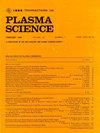Effect of Plasma Mode Frequency on Gaussian Laser Beam in Hot Plasma
IF 1.3
4区 物理与天体物理
Q3 PHYSICS, FLUIDS & PLASMAS
引用次数: 0
Abstract
The effect of plasma mode frequency on Gaussian laser beam in hot plasma was investigated, and the impact of ponderomotive force and electron temperature was taken into consideration The conductivity tensor of hot plasma was defined and the wavenumber as a function of plasma mode frequency was determined. Analytical methods were used to derive Gaussian parameters with respect to the frequency of the plasma mode. The current density induced by ponderomotive force significantly changes the dielectric constant of hot plasma. We found that waist, spot size, radius of curvature, and Gouy phase of Gaussian laser beam exhibit rapid decrease as plasma mode frequency increases, while the beam intensity follows a bell-shaped profile, which increases rapidly at the waist and decreases toward the edges. The results show that the laser beam becomes narrower and its intensity becomes higher than in vacuum. This phenomenon has complex nonlinear implications; it impacts self-focusing, self-modulation, generation of harmonics, and sidebands. Tightly focused beam conserves energy and improves energy transfer, providing efficiency in material handling and spectroscopy. The results presented in this work can be useful for advancing our plasma.等离子体模式频率对热等离子体中高斯激光束的影响
研究了等离子体模式频率对热等离子体中高斯激光束的影响,并考虑了深思动量和电子温度的影响。定义了热等离子体的电导张量,并确定了等离子体模式频率与波长的函数关系。利用分析方法得出了等离子体模式频率的高斯参数。深思动量引起的电流密度极大地改变了热等离子体的介电常数。我们发现,高斯激光束的束腰、光斑大小、曲率半径和古伊相位随着等离子体模式频率的增加而迅速减小,而光束强度则呈钟形曲线,在束腰处迅速增加,并向边缘减小。结果表明,与真空相比,激光束变得更窄,强度变得更高。这种现象具有复杂的非线性影响;它影响自聚焦、自调制、谐波的产生和边带。紧密聚焦的光束可以节省能量并改善能量传递,从而提高材料处理和光谱分析的效率。这项工作所展示的结果有助于推动我们的等离子体技术。
本文章由计算机程序翻译,如有差异,请以英文原文为准。
求助全文
约1分钟内获得全文
求助全文
来源期刊

IEEE Transactions on Plasma Science
物理-物理:流体与等离子体
CiteScore
3.00
自引率
20.00%
发文量
538
审稿时长
3.8 months
期刊介绍:
The scope covers all aspects of the theory and application of plasma science. It includes the following areas: magnetohydrodynamics; thermionics and plasma diodes; basic plasma phenomena; gaseous electronics; microwave/plasma interaction; electron, ion, and plasma sources; space plasmas; intense electron and ion beams; laser-plasma interactions; plasma diagnostics; plasma chemistry and processing; solid-state plasmas; plasma heating; plasma for controlled fusion research; high energy density plasmas; industrial/commercial applications of plasma physics; plasma waves and instabilities; and high power microwave and submillimeter wave generation.
 求助内容:
求助内容: 应助结果提醒方式:
应助结果提醒方式:


